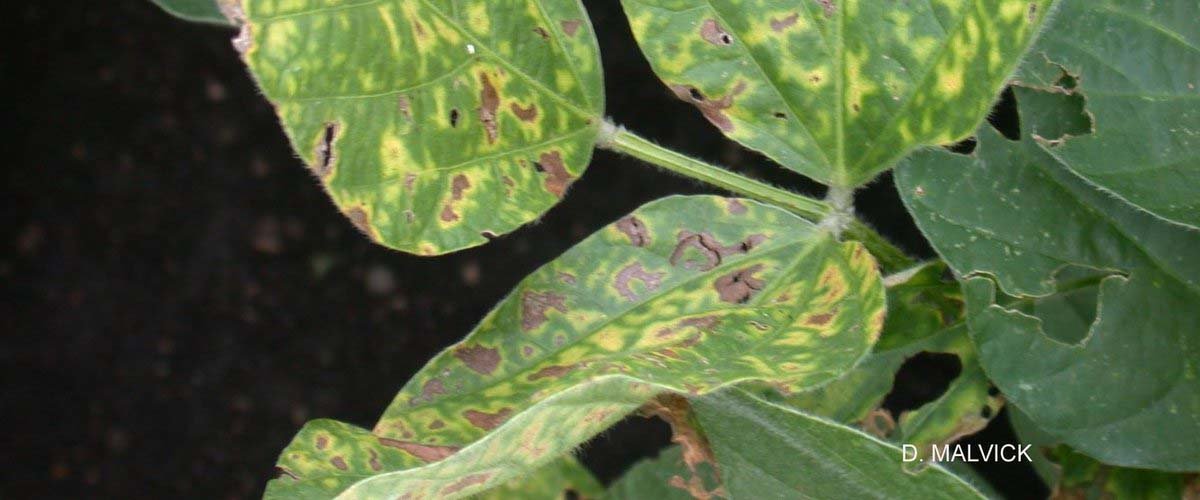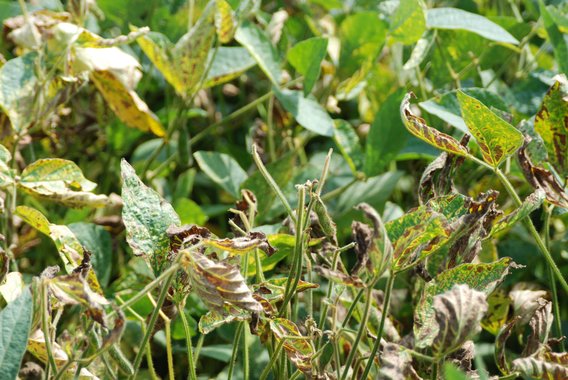
Beware: Mysterious fungus pathogens are among us
Diseases impact corn and soybean production in Minnesota

It shouldn’t be surprising that soybean and corn crops occupy the most acreage and have the highest economic value in Minnesota — more than 7 billion dollars in 2020. But did you know that these staple crops are vulnerable to several prevalent diseases that might affect crop production, which poses a risk to farmers? Given the abundance of corn and soybeans, it’s crucial to stay ahead of these new diseases.
Diseases constrain the yield and profitability of soybean and corn crops in Minnesota and the greater Midwest, but two have been the subject of concentrated research — corn Tar Spot and soybean Sudden Death Syndrome (SDS) — fungal diseases that can significantly reduce yield when preventative measures aren’t taken.

CFANS Department of plant pathology professor Dean Malvick, PhD, has been studying these diseases at the Southern Research and Outreach Center (SROC) and the Rosemount Research and Outreach Center (RROC). He leads research efforts aimed at diminishing the presence of these diseases in locations around the state where they have emerged.
Malvick’s research focuses on the biology of pathogens and their impact on plants while working toward improving disease management and diagnosis. He studies the characteristics of pathogens, gains understanding of the interactions between fungal pathogens, and develops useful disease management practices. He then works to validate specific molecular diagnostic techniques for detection of plant pathogens. Working between the SROC and RROC, at locations across the state, and at sites on the U of M Twin Cities campus in St. Paul, Malvick splits his time teaching, researching, and spreading knowledge about these pervasive plant diseases.
Soybean Sudden Death Syndrome
Soybean Sudden Death Syndrome (SDS) was only recently discovered in Minnesota. However in 1971, SDS made its initial appearance in the United States in Arkansas. Since then, it has spread north to Minnesota, first discovered in the state's southern region. There are large knowledge gaps in the dispersion of SDS; some of the key issues being researched are temperature thresholds, possible future spread, management, and potential pathogenicity to non-soybean crops. Since it was first discovered, SDS has remained relatively mysterious. “SDS is a tough nut to crack,” said David Kee, director of research at Minnesota Soybean Research and Promotion Council. “That is why Dean’s research has been consistently supported by the Minnesota Soybean Checkoff.”
The Minnesota Invasive Terrestrial Plants & Pests Center (MITPPC) has selected this species as a priority for research, with a focus on where the disease is developing and why. SDS causes root rotting, which results in a plant toxin that spreads from the root tissue into the rest of the plant. Symptoms of SDS are often not visible on the plant leaf until after the start of flowering. The emphasis on SDS surviving seasonal temperatures has been under investigation by Malvick's team due to the continuously warming winters in Minnesota. SDS is one of the most consequential diseases affecting soybeans in America, and the fungus that causes it is capable of surviving winter in crop residue and soil. Even if there are no obvious foliar symptoms of SDS in the early spring, the fungus can infect soybean roots.

This research has led to increased efforts in awareness and mitigation efforts by farmers across the Midwest, with projected outcomes to learn more and minimize the prevalence of this pervasive disease. This includes sharing and demonstrating information on the value of specific disease management practices, especially resistant varieties and seed treatment fungicides, to manage this widespread and damaging soybean disease.
Corn Tar Spot
Tar Spot was first identified in Minnesota in 2019 and most recently in southeastern to east-central Minnesota. The disease known as “tar spot of corn” harms corn plant leaves by infecting them with spores carried by the wind. Tar Spot should be treated as a serious threat that can cause yield loss of more than 20 percent for corn, the most widely grown crop in Minnesota. “Tar Spot is a threatening disease because of how severe and widespread it has become. Blown by the wind, spores may be capable of traveling long distances affecting crops, although this is poorly understood,” said Malvick.
Proactive disease monitoring and management helps keep our food, feed and fiber supplies stable and prevents economic losses for farmers. Spraying fungicides is an important part of Tar Spot management, and Malvick and his team are exploring the effectiveness of fungicides and resistant hybrids to manage the disease in Minnesota. The project includes research activities spanning across laboratories, greenhouses, plant growth chambers, and field locations as part of a comprehensive study and analysis of the critical plant pathogen.

Outcome
Malvick's research team is hoping to understand how weather and climatic factors relate to this diseases’ development. Weather has proven to be a significant factor. Through his research Malvick keeps in touch with farmers, agribusinesses, and Extension educators throughout this project to keep them informed of the research results and to share management techniques that are efficient, affordable, and ecologically friendly. Results and information about newer, more detailed information about the risk of tar spot conditions are encouraging for our understanding of how these diseases grow and spread. Malvick will continue this critical research and aims to expand scouting and diagnosis for these diseases, and to encourage identification to understand where these diseases are emerging and need to be managed, and to inform stakeholders in how to manage the disease. “Tar Spot and SDS will continue to have an effect on crop production and yield, so our work is to mitigate these diseases as we learn more about their behavior, impact and spread,” said Malvick.





